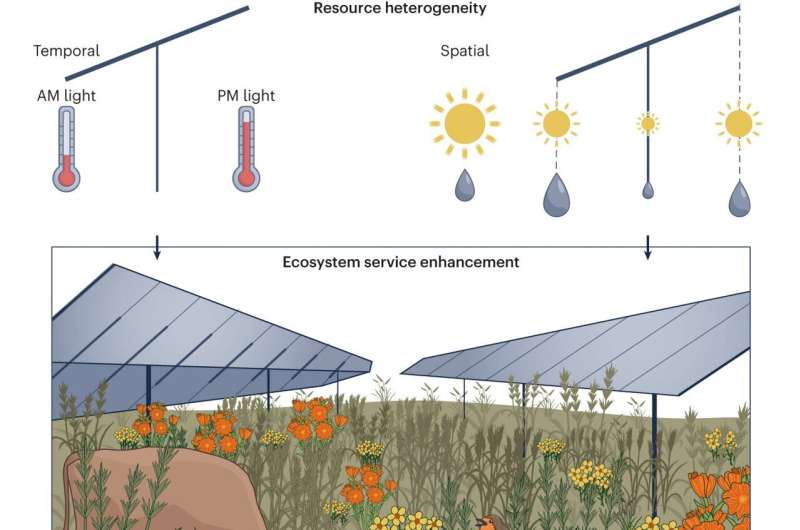How can solar energy installations prioritize ecosystems?

Solar energy will be an integral part of a more sustainable future, but with current technology, generating the amount of power needed in Colorado alone would require using roughly the land area of Denver.
That's a lot of space—and potential disturbance to ecosystems, especially when you consider that in the past, energy companies have typically first graded the land and then put gravel or short, easy-to-mow turf grass beneath their solar panels.
Agrivoltaics—the dual use of land for both solar installations and agriculture—offers an alternative way to generate renewable solar energy. Now, two Colorado State University researchers are proposing taking this a step further through what's known as "ecovoltaics," which co-prioritizes energy production and ecosystem services during the design and management phases of solar development.
"It's important to talk about the sustainability of the solar industry so it doesn't make the same environmental oversights as oil and gas," said Matt Sturchio, a Ph.D. student in Biology and the Graduate Degree Program in Ecology. "With ecovoltaics, we hope to encourage an ecologically informed approach to solar array design and operation."
Sturchio and CSU Biology Professor Alan Knapp outlined this concept in an article in the journal Nature Ecology and Evolution.
"It will take a lot of solar panels and a lot of land to produce the electricity our society needs," Knapp said. "As a land-grant institution, we see ourselves as stewards of the land, and it's our job to offer sustainable solutions about how to use land wisely."
Solar panels create unique microenvironments
While agrivoltaics is a step in the right direction, Sturchio said in many applications, it still prioritizes producing the most electricity possible in a given land area. This allows for the use of land beneath solar panels but overlooks opportunities to manipulate array designs in ways that might benefit the plants and animals beneath, especially in water limited ecosystems like the grasslands of Colorado.
With ecovoltaic designs, solar energy production and preserving the landscape go hand-in-hand.
The ecovoltaic concept is partly informed by the researchers' current work at Jack's Solar Garden in Longmont, which is the largest commercially active site for agrivoltaics research in the U.S.
Here, the CSU team studies how solar panels affect sunlight patterns and redistribute rainfall to create microenvironments that influence grassland ecosystem processes. These microenvironments promote diversity within solar installations and are a cornerstone of the ecovoltaics concept.
"What we're trying to do is show the potential impacts of solar energy on our land, and how we can mitigate and potentially leverage them to reach desired outcomes," he said.
And perhaps most importantly, these approaches can be used to restore severely degraded or abandoned agricultural lands—which are prime candidates for large solar installations.
"Ecovoltaic approaches could help restore and even enhance biodiversity in these places, while providing much-needed clean energy," Sturchio said.
'It's a climate solution'
Sturchio and Knapp will continue their research at a new facility in the plains east of CSU's campus in Fort Collins.
Here, solar panels will be installed in a native grassland environment—offering new insights about how they impact the ecology of places that are known to be harsh and dry, and where conditions are expected to become more volatile as climate change worsens in the future.
"Building our own research solar arrays will allow us to discover better ways to use this amazing energy source and will help us determine what we can do to make sure large-scale solar installations have less of a negative impact," Knapp said. "We will study the impacts of placing solar panels farther apart, changing their orientations, and orienting panels vertically during rainstorms—there are many potential options."
Sturchio said he's hopeful that energy companies will use some of these principles as they build future installations.
"This research is really important because it's a land use solution for a climate solution," he said.
More information: Matthew A. Sturchio et al, Ecovoltaic principles for a more sustainable, ecologically informed solar energy future, Nature Ecology & Evolution (2023). DOI: 10.1038/s41559-023-02174-x
Journal information: Nature Ecology & Evolution
Provided by Colorado State University Researchers evaluate potential land use of solar panels on Tennessee farmland
No comments:
Post a Comment